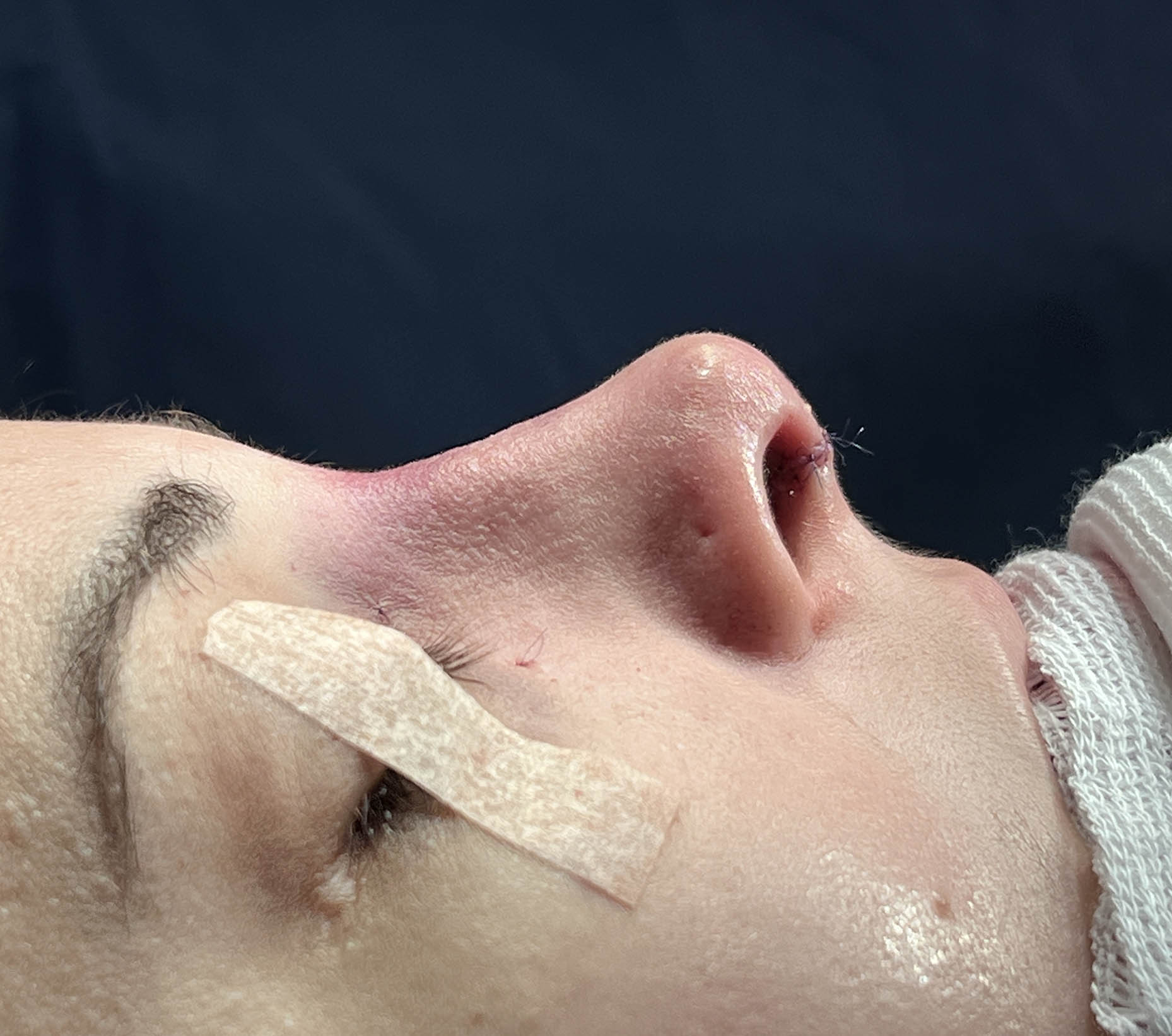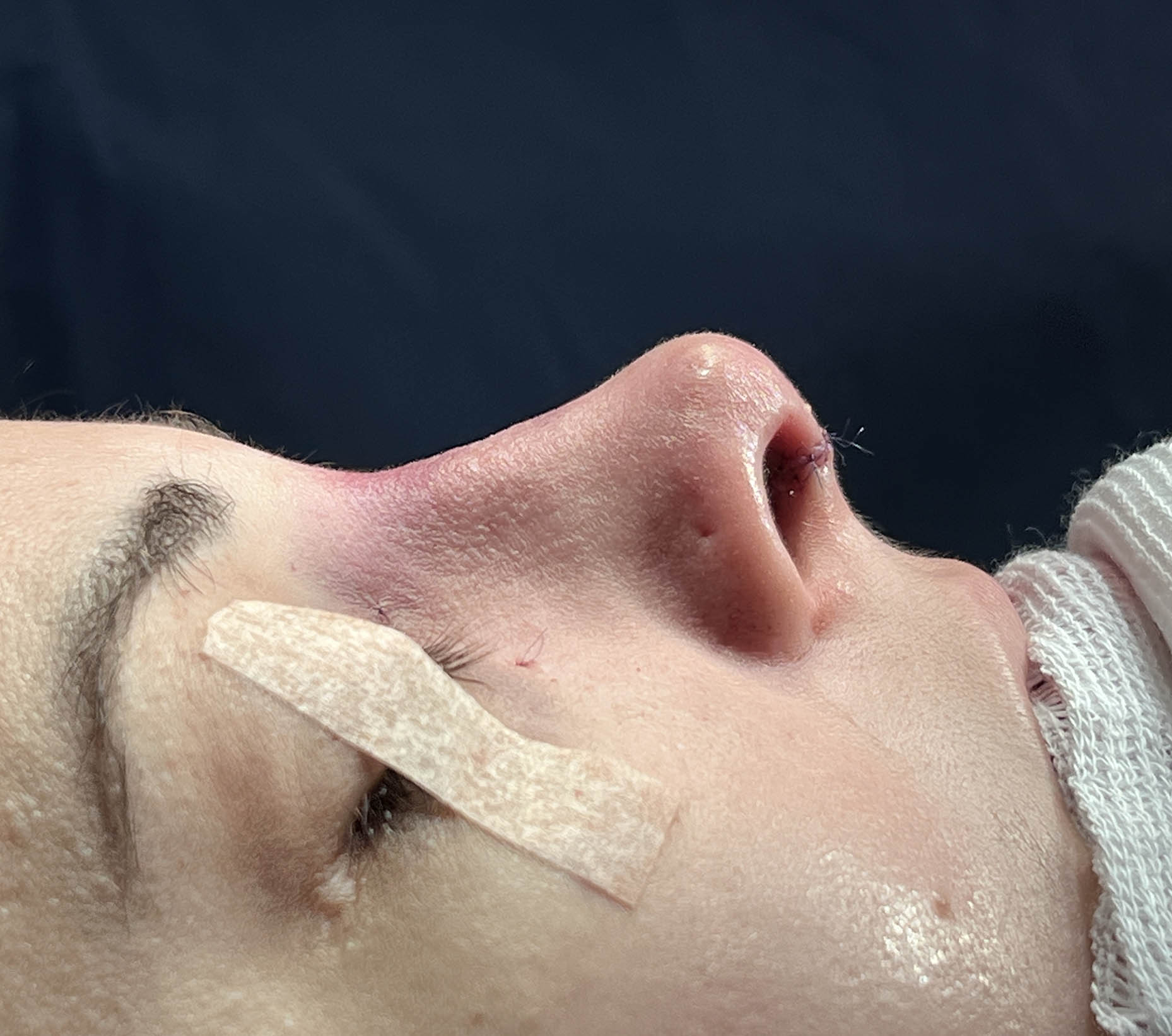Preoperative
Nose Assessment
Patients who wish to undergo a rhinoplasty plastic surgery in Londrina undergo a thorough evaluation
with Dr. Walter Zamarian Jr, who will explain the procedure, study the patient's facial structure based on mathematical formulas, thus being able to determine which areas of the nose will undergo greater changes in
order to have the expected rhinoplasty result and if there will be any segment of the nose with expectations limited by several factors, such as, for example, the thickness of the nasal skin, the fragility of the bones of the nose, among others.
Aesthetic parameters of the nose
Briefly, we can mention here some parameters that the plastic surgeon takes as a basis to determine the points
to be improved. They are mathematical parameters and proportions, so they help to measure what is visibly altered.
It should be remembered that these parameters serve only as a guideline, and each nose has its particularities and measurements outside these parameters are totally acceptable, considering that there is harmony with the face, always reminding us of the ethnic differences that must also be taken into account.
The thirds of the face
In order to obtain predictable and more concrete results, the plastic surgeon divides the face in three, using four horizontal lines:
- a tangent to the hairline (variable and less important line);
- a line at the eyebrow level;
- another at the nasal base and
- the last tangent to the chin (chin).
Divergences in these proportions may indicate maxillofacial alterations, such as vertical maxillary excess, known as "bird face" or maxillary hypoplasia.
As it is the foundation of the nose, that is, where it is located, important changes in the maxilla must be treated before rhinoplasty.
Nose Length
In order to have a certain idea of what to do when the discomfort starts from the length of the nose, one must analyze whether the length of the nose is equivalent to the vertical distance between the oral commissures (angles of the mouth) and the lowest point of the chin, in a frontal view. In this way, Dr. Zamarian can confirm whether the length of the nose is proportionately unsightly or not for the surgery.
Deviated nose
A straight vertical line is drawn that goes from the middle of the glabella (region between the eyebrows) to the chin, dividing the nasal dorsum, upper lip (with its Cupid's Bow) and incisors in the middle (so that it is parameter, the patient has a normal bite). Any nasal deviation from this line, called laterorhinia or "crooked nose", is likely to require an osteotomy (fracture of the nasal bone) and septoplasty.
Base of the nostrils
The normal distance between the nasal wings is equivalent to the distance between the medial corners of the
eyes (intercantal distance), or the width of the opening of an eye. If the distance between the nostrils is greater than the intercantal distance, the cause should be studied first. If the cause is a narrow intercantal distance, it is better to leave the wings of the nose slightly open, proportionately, than to surgically correct the distance between the eyes. If the nostrils are truly wide, closing the nostrils may be indicated.
Stylus shape
The nasal tip is evaluated by drawing two triangles with their opposite bases, guided by the "supratip break" and by the columelolabial angle (formed between the lip and the outer septum, the columella). If these triangles are asymmetrical, it may be necessary to perform maneuvers to modify the tip of the nose.
In addition to modifying asymmetrical tips, it may be necessary to thin the nasal tip, especially in patients with a bulbous nasal tip, the famous potato nose.
Baseline view of the nose
In the basal view of the nose, the nostrils and the base of the nose are evaluated, which must describe an
equilateral triangle, with a ratio between the lobe and the nostril of 1:2. The nostril should be in a teardrop shape, with its major axis oriented slightly medial (from base to top).
Frontonasal angle
This angle connects the glabella (space between the eyebrows) to the root of the nose, in a smooth curve, whose angle should be between 128 and 140 degrees, more specifically 134 degrees in women and 130 degrees in men.
Projection of the tip
In the side view of the nose, the tip projection should be equal to the width of the nostrils in a frontal view and 67% of the length of the nose (from root to tip). Another way to evaluate the projection of the nasal tip is to know how much it is projected anteriorly to a perpendicular line to the most anterior point of the upper lip. This previous projection is normally equal to 50 to 60% of the total tip projection.
Nasal dorsum
The analysis of the dorsum starts by drawing a line parallel to it, which goes from the root of the nose to the tip. In women, the ideal position of the back is about 2 mm below this line and almost parallel to it. In men, the dorsum should be very close to this line, to avoid feminization of the nose.
Usually, the tip is slightly more projected than the dorsum of the nose and the plastic surgeon can lower the dorsum, raise the tip, or perform these two techniques during surgery, in order to obtain the best result for each case.
Columelolabial angle
It is the angle formed between the columella and a plumb line perpendicular to the natural
horizontal plane of the face. This angle should be between 95 and 100 degrees for women and between 90 and 95 degrees for men.
Columella
Also known as sub-septum or mobile septum, the columella, the column of skin between the
nostrils, can also be corrected. Basically, there are two unsightly defects of the nose that can involve the columella: the retracted columella and the hanging columella .
A retracted columella is one that is “hidden” due to lack of skin or cartilage in that region. The
columella hanging, in turn, stands out for having excess skin and cartilage in that region, causing it to
be protruding, that is, pedant, between the nostrils and both cases can be improved. How to know if the columella is pending? It is not always that the formulas go according to the patient. There are cases that only by visual evaluation, the plastic surgeon can detect the problem. Dr. Walter Zamarian Jr, in addition
to performing a visual assessment, basically uses mathematical calculations to solve this rhinoplasty problem: according to the image, when A – B is greater than 4 mm, it means that the columella is altered.
Fortunately, both columella defects can be resolved. Dr. Walter Zamarian Jr uses cartilage removal or grafts to correct such problems.
Assessment of the thickness of the skin of the nose
The nasal dorsum is formed by the osteo-cartilaginous structure and the thickness of the skin
that covers it. The skin that covers the entire nasal structure is not uniform in thickness, being thinner in its upper two thirds (root) and thicker at the tip. In addition, the upper part of the skin is more mobile and has fewer sebaceous glands than the part that covers the tip of the nose.
The skin of the nose covers everything that is performed below it during rhinoplasty, which is why Dr. Zamarian draws attention to this important detail: the thick-skinned nose shows less of the refinements made, and the thin fur shows the smallest details.
Just as a thick blanket has a hard time showing what's underneath, a person with thick skin might have a hard time getting a very thin nasal tip.
Overall, patients with predominantly thinner nose skin will achieve the desired results faster and more pronounced when compared to patients who have predominantly thicker skin. These will have to wait a little longer for the results to reach complete healing.
Assessment of anterior septal angle: is there support at the tip?
In order for the plastic surgeon to know if there is support on the nasal tip, there is a simple test that allows you to see it immediately, which is done by simply squeezing the tip of the nose with your finger. If the nose sinks, it means it has little support, so it can be corrected. In these cases, Dr. Zamarian can conclude whether there is a need to lower the tip or not. If it remains in the same place, sinking a little, it is a sign that the tip of the nose is well supported, so there is no need to make changes to this element.
Medications that should be discontinued before surgery
Dr. Zamarian contraindicates the use of certain medications before the surgery, as there are some medications that interfere with blood clotting, sedatives, anesthesia and adrenaline, which must be suspended for a period of fifteen days before and after this cosmetic surgery. . Among them are:
- Acetylsalicylic acid, known as AAS, which is marketed under the name Aspirin, Alka seltzer, Bufferin, etc.;
- Ginko biloba;
- Arnica, by directly interfering with blood clotting;
- Tricyclic antidepressants (amitriptyline, clomipramine, nortriptyline, etc.);
- Oral anticoagulants (marcumar, marevan, etc.);
- Appetite suppressants and weight loss medications (amphetamines, sibutramine, etc.).
Always tell your plastic surgeon about all medications you take, including natural ones.
Required exams
Before performing nose plastic surgery, it is necessary to carry out some tests, so that Dr. Zamarian can assess the patient's health, including providing greater safety to the procedure. Tests that are usually ordered before rhinoplasty are performed include:
- Complete blood count;
- TAP with INR + KPTT;
- Urea and creatinine;
- Fasting blood glucose;
- Total proteins and fractions;
- Urine I;
- Electrocardiogram;
- Surgical risk (assessment with a cardiologist);
- Radiography:
profile of the bones of the nose and mentalis plate (sinuses).
To perform rhinoplasty, whether primary or secondary, it is important for the plastic surgeon to know about the nasal breathing capacity of each patient before performing the nasal plastic surgery, as well as a history of trauma in the past, previous surgeries, rhinitis or sinusitis. Deviated septum and the nose as a whole are evaluated. Dr. Zamarian usually performs an examination of the inside of the nose, looking for synechiae, deviated septum or turbinate hypertrophy for a complete evaluation.
Anesthesia
For a complete plastic surgery of the nose, which involves nasal osteotomy (bone fracture), grafts up to the tip treatment, general anesthesia is indicated, because in these cases, only local anesthesia is not satisfactory and safe for the patient. patient. As for the cases where Dr. Zamarian indicates only the tip treatment, the procedure can be done with local anesthesia and venous sedation only.
We use the term “general anesthesia” to refer to the anesthetic technique that promotes total unconsciousness (hypnosis) of the patient, pain relief (analgesia) and muscle relaxation. General anesthesia makes it possible to perform any necessary maneuver during nose surgery. Local anesthesia leaves the plastic surgeon a little limited, and this type of anesthesia is not indicated when the patient must undergo an osteotomy, for example.
After anesthetic induction, which is the period of transition from consciousness to the patient's unconscious state, the preparation of the nasal vestibules is necessary, at which time the plastic surgeon must trim the nasal vibrissae (nasal hairs) and perform the antisepsis on the inside and outside of the nose.
After preparing the vestibules for nose plastic surgery, approximately 20 ml of a solution with 1% lidocaine and 1:80,000 adrenaline is injected to minimize bleeding during rhinoplasty, thus also preventing ecchymoses (purple ) and postoperative pain.
The areas of the nose where this solution is applied before rhinoplasty are: nasal dorsum, tip, anterior nasal spine, fracture line, alar mucosa and septum. Dr. Zamarian waits approximately 12 minutes for the full vasoconstrictor effect of adrenaline before starting the procedure.
To provide greater patient safety, our specialized anesthesiologist monitors the entire surgery, from beginning to end, together with Dr. Zamarian. The presence of the anesthesiologist during the surgery is essential to monitor the patient's pressure, pulse, temperature, breathing, degree of sedation, diuresis and hydration throughout the procedure.


